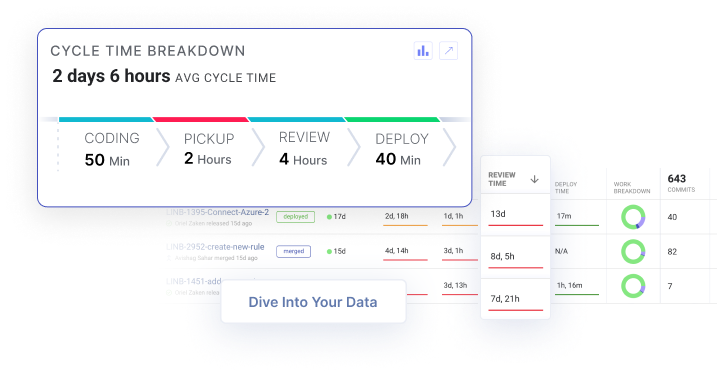Your teams are working hard to develop new software and deliver features, but you don’t always have concrete data to show other execs what they’re working on. And to make things worse, your org may be dealing with roadblocks in its software development process and you’re not sure how to help them overcome these obstacles.
The best way to overcome these challenges is to focus on engineering efficiency. This will help you understand your teams’ performance and improve it, so you can release features more frequently and communicate delivery timelines with confidence in meetings.
So, what exactly does engineering efficiency mean? And which metrics do you need to track to improve engineer efficiency? Let’s take a closer look.
Engineering efficiency means measuring the output of work compared to the expected outcome.
What Is Engineering Efficiency?
Engineering efficiency means measuring the output of work compared to the expected outcome. As in, you want to see how your teams performed compared to the initial plan. Did they go over budget and time? And if so, by how much?
Engineering efficiency is essentially a combination of three core beliefs:
- Improving your developer experience to improve teams’ performance, including optimizing the engineering process
- Maintaining your org’s tempo to ensure your teams are keeping up with the flow. This entails measuring DORA metrics and adding automation to your devs’ workflows.
- Staying aligned with your business needs to keep your engineering org moving in the right direction. This means ensuring your devs are hitting their goals on time and have the best tools for the job.
How NOT to Measure Engineering Efficiency
 On the grand timeline of software development, we are incredibly close to ushering in a new golden age. But we’re also close to falling backward too!
On the grand timeline of software development, we are incredibly close to ushering in a new golden age. But we’re also close to falling backward too!
But the problem is, your execs always want you to maximize company profits. And at the same time, you need to ensure your engineering org has everything they need to do their jobs. That’s not an easy situation to be in.
Following your execs’ common company culture may easily toss you into a massive pitfall, because you’ll start focusing on the wrong metrics to stack rank devs. And your engineering leaders and devs will suffer for it, too, with things ending up broken and your tech debt piling up.
To top things off, in the current economic climate, it can be very hard to give your devs everything they need to succeed without going over budget.
So how can you navigate this and satisfy both parties? The key is focusing on improving the efficiency of your org. This will satisfy both the execs and your teams, and you’ll be ushering your company into a new golden age.
3 Mistakes to Avoid
Improving your efficiency may be easier said than done. For example, you may be falling into some common mistakes that are doing you more harm than good.
1. Stack Ranking Devs
As the saying goes, “There’s no I in team”, and the same goes for your engineering org (not really, but you get the idea). So if you only focus on individual metrics and rank your devs based on metrics such as lines of code, you’ll never get a complete idea of how your teams perform and how efficient they are.
You can’t expect a junior dev to have the same skills as a senior dev who’s been on the team for years, so why compare them? Teams should work as a cohesive unit, not cogs in the machine.
2. Creating a Competitive Culture
Fostering a competitive culture often ends up being detrimental in the long run. When your teams are always trying to one-up each other, you’ll only get frustrated devs and bad code, which nobody wants. Instead, you need to create a collaborative culture among your teams to improve overall developer experience.
3. Misusing Valuable Metrics
Some metrics aren’t inherently harmful — but they create problems when you don’t use them as intended. For example, measuring velocity will only show you you’re going fast, but that doesn’t matter if you’re not going in the right direction. And if you measure lines of code, you won’t know whether the work aligns with business needs.
Instead, value the metrics that actually show how teams perform and how they’re doing, which helps set them up for long-term success. And those are the metrics we’ll be talking about next.
Kathryn Koehler, Director of Productivity Engineering at Netflix, had a similar issue with developer velocity and outcome vs. output. Check out what she had to say about it!
4 Most Effective Engineering Efficiency Metrics
Now that you know what NOT to prioritize, let’s jump into the four metrics that will help you and your engineering org the most:
1. Merge Frequency
A team’s merge frequency is the cumulative number of pull requests merged over a specific timeframe. Higher merge frequencies mean you have a well-functioning software delivery workflow, and nothing is getting caught in a roadblock.
Monitoring merge frequency will help you accurately measure engineering efficiency — more accurately than using individual metrics such as lines of code.
If code isn’t being merged, it doesn’t matter how many pull requests devs make or how many lines of code they type. The biggest culprit for poor merge frequencies is usually the PR lifecycle. So, if you can streamline this process, your devs will be able to work with minimal context switching, and your efficiency will skyrocket.
 Improve your engineering efficiency with gitStream! It’s free on the GitHub marketplace. Learn more.
Improve your engineering efficiency with gitStream! It’s free on the GitHub marketplace. Learn more.
2. Cycle Time
Cycle time refers to the amount of time it takes for a project to go from the first commit to the final release to production. And we all know how many things can happen between these two points, which gives this metric its weight.
If you want to maximize efficiency in your teams, you’ll want a shorter cycle time. It’s an excellent indicator of how well-oiled and efficient your software development lifecycle is and shows you’re offering value to clients at a faster rate.
So how can you know exactly what’s impacting your cycle times? You need deeper visibility into each stage of the development process. That’s why LinearB divides cycle time into four phases: coding, pickup, review, and deploy times. This way, you can assess how long each stage is taking and see what’s the holdup.
 Get context around cycle time bottlenecks in one click. Diving into your data has never been this easy. Get started with our free-forever account today!
Get context around cycle time bottlenecks in one click. Diving into your data has never been this easy. Get started with our free-forever account today!
On top of that, LinearB’s Engineering Benchmarks show where your engineering org excels and where you have some opportunities for improvement. And with LinearB’s developer bot, WorkerB, and Team Goals, you can then create a system that both measures and improves your org’s power output and efficiency.
3. Planning Accuracy
Planning accuracy measures the proportion of story points or issues resolved compared to the total expected in an iteration. This metric essentially tells you how well you plan your sprints. But according to LinearB’s Engineering Metrics Benchmarks study, the planning accuracy for 1,900 engineering teams was below 50% on average.

If your teams can deliver predictably, your entire company will feel the positive impact. Marketing can support feature launches with effective campaigns. Sales and customer success can promise clients and prospects new features and close deals. Even your executives benefit by more confidently committing to revenue targets. How’s that for an efficient engineering org?!
4. Resource Allocation
The amount of time and effort your teams invest into each project is measured through resource allocation. Having the right context into your teams’ needs and wants is essential. But it also opens up avenues for healthier discussions with execs when it comes to adding projects and features during sprints.
Bonus points: measuring resource allocation also helps keep teams on track by visualizing where resources are going. That way, your org is better equipped to deal with going over budget or missing deadlines.
And because resource allocation facilitates conversations about balancing competing needs with scarce resources, it’s an essential metric to improve your engineering efficiency. It allows you to ask questions like, “Are we working on the most crucial tasks for the organization?”. That way, you can steer your teams in the right direction to ensure that what they’re working on always aligns with business needs.
How to Improve Your Engineering Efficiency
To make a serious impact on your engineering org, you need to start taking your overall engineering efficiency seriously. This means you’ll need to adopt a platform that can help you track metrics and take action to improve them. And the best platform for that is LinearB.
With LinearB, you can remove all the guesswork and stop worrying about inadequate metrics like lines of code. Our developer productivity platform doesn’t just show you the metrics you need to improve. It helps you automate workflows and take action to help devs improve these metrics, too!
When you track the essential metrics with LinearB, you can then start optimizing processes with Team Goals. This will help you spot and clear bottlenecks in devs’ processes, improving your cycle time as a result.
And with LinearB’s tools like WorkerB and gitStream, your teams will dramatically improve their developer experience. These tools take away the tedious tasks of creating tickets for unplanned work and improving your PR processes, leaving your developers with more time to work on the things that matter most.
 We know that improving engineering efficiency is important. Learn more about our four-step recipe for improvement.
We know that improving engineering efficiency is important. Learn more about our four-step recipe for improvement.



